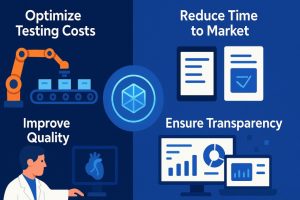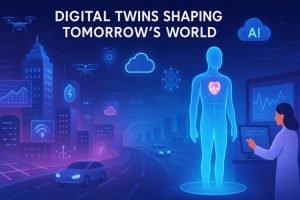Table of Contents
ToggleWhat is a Digital Twin and Why is It Being Talked About All Over the World?
In recent years, the term ‘digital twin’ has been actively used by technical specialists, engineers, doctors, and even urban planners. This is not just a buzzword, but a revolutionary approach to creating accurate virtual copies of physical objects, systems or processes that operate in real time.
With the help of modern algorithms, sensors and cloud technologies, digital twins allow us to model, predict and optimise various areas of life.
The application of such simulations covers both industrial production processes and city management, aviation, energy, and medicine. Space agencies pioneered the use of this concept, applying it to control complex vehicles.
Today, this method has also become available for commercial use – from logistics systems to the gambling business, where, in particular, new formats are developing, such as non gamstop no deposit bonus, based on digital modelling algorithms.
The uniqueness of digital models lies in the ability to combine data from the real world in one virtual space. This ensures a high level of predictability and adaptability, which is extremely valuable in a dynamic world. It is precisely because of this ability to adapt that interest in digital twins is only growing.
How Digital Twins Work?

A digital twin operates on the basis of a combination of three main components: a physical object, a virtual model, and a two-way data exchange channel. This allows for real-time monitoring and analysis of parameters, such as temperature, humidity, pressure, or motion.
Key Stages of Creating a Digital Display
There are several important steps involved in building a full-fledged digital equivalent:
- Collecting information from sensors and sensors.
- Building a mathematical or visual model.
- Setting up feedback channels with a physical object.
- Constantly updating data and adapting algorithms.
These steps ensure that the digital copy is as close as possible to its real analogue.
Interaction with AI and cloud services
Artificial intelligence plays an important role in the development of the concept. Its algorithms analyse complex scenarios and behavioural models. Combined with cloud computing, this opens up endless possibilities for scaling and storing information.
Areas of Application for Digital Twins
Virtual copies of real objects can be useful in a variety of industries. They are used not only to test ideas but also to make strategic decisions.
Industry and Manufacturing
In mechanical engineering, energy, and aviation, digital twins are used to predict wear and tear of parts, optimise production lines, and check safety. This helps to minimise risks, reduce costs, and increase efficiency:
- Emergency modelling.
- Analysis of potential breakdowns.
- Risk-free testing of new prototypes.
Healthcare
In healthcare, such technologies open up new horizons: from creating individual patient models to testing new drugs without clinical risks. For example, it is possible to predict how a particular organism will react to a certain treatment before it is administered.
Urban Planning and the Environment
Digital city models help to better understand how conditions in megacities are changing. They make it possible to visualise traffic flows, calculate the load on infrastructure, and model the development of urban areas.
Benefits of Using Digital Twins

One of the main advantages of such technologies is the ability to simulate, analyse and adjust system behaviour without interfering with the physical object. This means that errors can be detected at the stage of virtual modelling, saving resources and time.
In addition, digital twins allow you to:
- Reduce testing costs
- Increase the speed of bringing a product to market
- Improve the quality of the final result
- Support continuous modernisation
This tool also contributes to greater transparency of business processes and helps developers see the whole picture.
Challenges and Risks Associated With Digital Twins
Despite the obvious benefits, the use of digital models is not without its challenges. One of the main challenges is data protection. Given that digital twins operate on the basis of a large amount of information, the security of personal and technical data becomes a key challenge.
Complexity of Integration
Another important issue is the integration of digital models into existing systems. Not all companies have the necessary resources or expertise to fully implement these solutions. The complex architecture of digital twins requires precise configuration and maintenance.
Dependence on High-quality Data
Insufficient accuracy or incorrect reading of parameters from physical objects can reduce the efficiency of a digital copy. Therefore, it is necessary to pay great attention to the quality of the input data.
The Future of Digital Twins: New Horizons

Every year, digital twins become more and more intelligent. They can independently adapt to new conditions, learn, draw conclusions, and anticipate changes before they occur. This opens up many prospects, including:
- Creating virtual humans to test social theories.
- Development of smart cities with self-regulating systems.
- Use in military training and security systems.
This approach is already changing the way humanity plans infrastructure, treats diseases, and runs businesses. A future in which digital twins become a normal part of life is no longer a fantasy.
The UK and the Introduction of Digital Twins
In the UK, digital twin technologies are actively supported by government institutions. London is already testing models of urban infrastructure to reduce congestion and improve air quality. The country’s medical research centres use virtual models of organs to plan complex surgeries.
British universities, such as Cambridge and Oxford, are actively researching in this area. They cooperate with companies that develop digital platforms that can be adapted for various industries, from healthcare to entertainment, where simulation solutions are increasingly used, including formats such as 10 free casino no deposit, which combine gamification with technological approaches.
Conclusion: Digital Twins Are a New Era in the World of Technology
Digital twins are steadily transforming from a concept of the future to a tool of the present that is already influencing numerous industries, from healthcare to energy.
They are becoming a bridge between the physical world and its virtual representation, allowing us to analyse, test, optimise and predict events with unprecedented accuracy.
These innovations are opening up unprecedented opportunities for humanity to manage complex systems, minimise costs and improve the quality of service.
Engineers, doctors, urban planners, and manufacturers are already beginning to integrate these digital replicas into their daily practice, and the scope of application is only expanding every year.
However, along with new perspectives come new challenges: ethical dilemmas, data leakage risks, security and legal issues. The ability of society to adapt to change and responsibly implement new technologies will determine whether digital twins will become a driver of sustainable development or a source of new threats.
The future of digital twins is not just another technical breakthrough, but a transformation of our approach to reality. The only thing left to do is to be prepared for this transformation and learn how to manage it for the benefit of the whole society.




